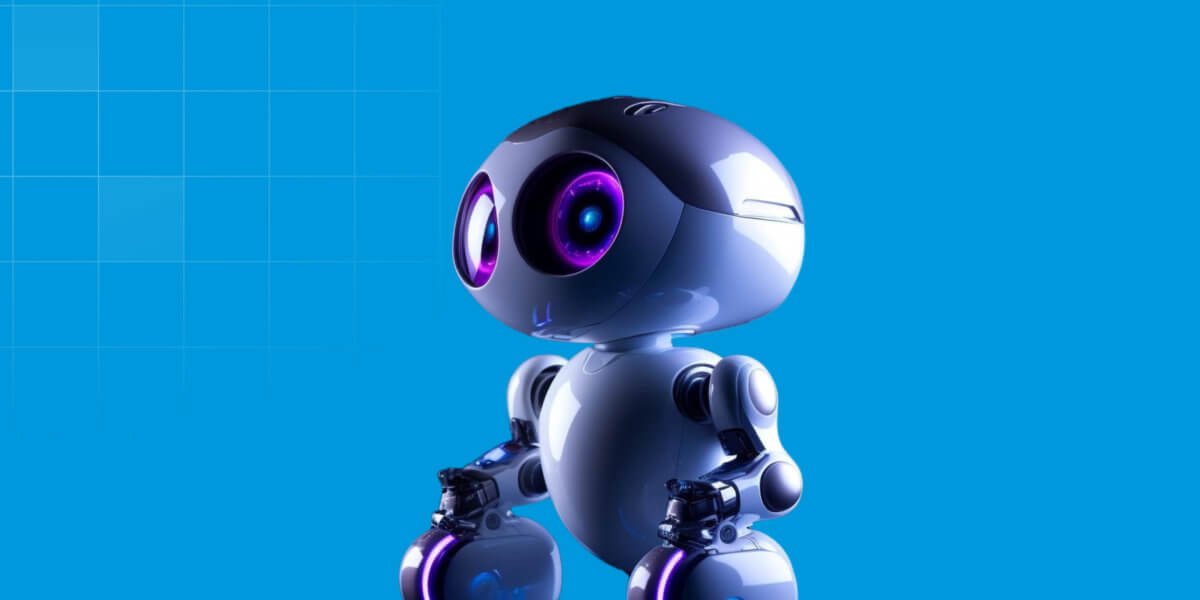
100 Top Chatbot Statistics for 2025
- April 10th, 2025 / 8 Mins read
-
 Aarti Nair
Aarti Nair
Understanding top AI chatbot statistics for 2025 is essential if you want to see the clear benefits that AI brings to customer service. These figures help you measure how automation can reduce costs and improve service. For example, chatbots can automate up to 30% of tasks handled by contact centre staff, potentially saving 23 billion in operational costs in the USA alone.
Let us tell you the story of Jane.
Jane is a customer service manager. When her team spent many hours answering the same questions, she turned to AI chatbots. The chatbot stats confirmed what she observed—faster response times, reduced workload, and improved customer satisfaction. By knowing these key numbers, you can make informed decisions about investing in technology that drives efficiency and real benefits for your business.
AI-powered chatbots and virtual assistants have completely changed the way businesses communicate with customers for marketing, sales, and customer support. And businesses that are not leveraging this dynamic solution are giving way to their competitors in 2025.
Companies digitised many processes due to the COVID-19 pandemic, and customers embraced these processes with open arms. This path led to the widespread use of efficient tools like chatbots for customer support, lead generation, and sales.
Therefore, we bring you the 100 Best Chatbot Statistics for 2025.
For easy consumption, we’ve divided the list into 8 different segments. With 100 chatbot statistics, once you reach the end of this blog, you too can be a Chatbot expert!
The segments are as follows:
- Chatbot Market Statistics
- Trends
- Customer Demand
- Company Supply
- Challenges
- For Customer Acquisition
- For Customer Support
- By the Numbers
Chatbot Market Statistics

- Chatbots will generate over $454.8 million in global sales by 2024. (Demandsage)
- The global chatbot market is expected to reach USD 15.5 billion by 2028, growing at a CAGR of 23.3% between 2023 and 2028. (MarketsandMarkets)
- The global chatbot market value was at $703 million in 2016. (Outgrow)
- The chatbot market value is expected to grow from $17.17 billion in 2020 to $102.29 billion by 2026. (Research and Markets)
- The solutions segment is projected to capture a dominant share of approximately 62.0% of the global revenue. (Grand View Research)
- 23% of client service companies actively utilised AI chatbots. (Masters of Code)
- 80% of sales and marketing leaders implemented or planned chatbot integration into the customer experience. (Masters of Code)
- There are over 300,000 chatbots on Facebook Messenger. (Venture Beat)
- The usage of chatbots has surged dramatically by 92% since 2019. (Masters of Code)
- Currently, chatbots are utilised by 24% of enterprises, 15% of mid-sized companies, and 16% of small businesses. (Tech Report)
- 80% of voice searches are predicted to be conversational in nature in 2024 (Synup)
- 25% of online searches made on Windows 10 are voice-based. (G2)
- Forty percent of support teams report that live chat software is among their most frequently used tools. (Livechat)
- The United States, India, Germany, the United Kingdom, and Brazil are the top 5 Chatbot using countries. – (Chatbots Life)
- 56% of companies say conversational bots are driving disruption in their industry, and 43% report their competitors are already implementing the technology. (AI Multiple Research)
- Among companies using AI bots, 46% employ them for voice-to-text dictation, 26% for team collaboration, and 24% for managing employee calendars. Additionally, 14% utilise digital assistants for service support, and 13% for IT help desk management. (Master of Code Global)

Chatbot Trends
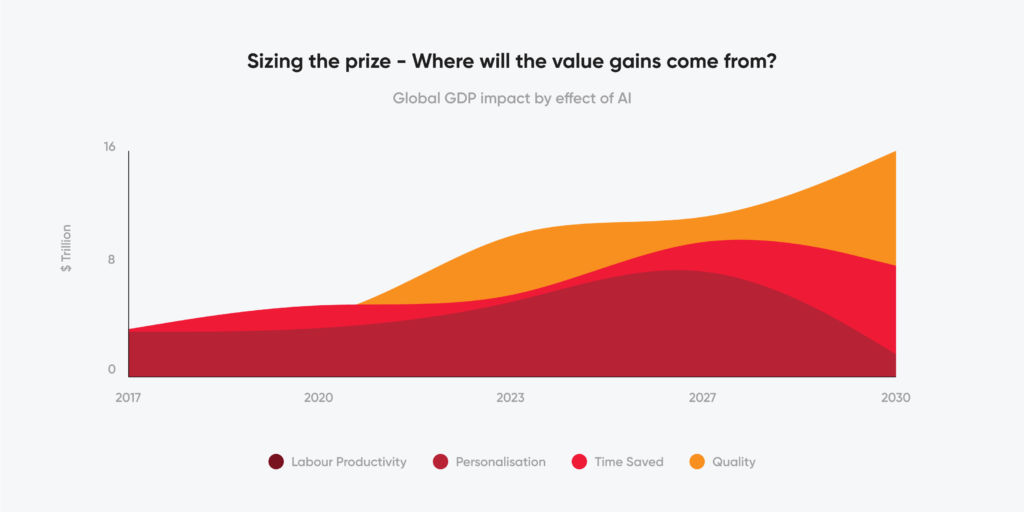
- According to Google Trends, interest in voice AI has increased almost 3 times over a period of 5 years (Google Trends).
- By 2025, AI will power 95% of customer interactions, meaning 19 out of every 20 customer interactions will be AI-assisted. (Forbes)
- Gartner predicts that by 2024, chatbots will manage an impressive 85% of all customer interactions without any human intervention. (Gartner)
- Just 8% of customers interacted with a chatbot during their most recent customer service experience. (Gartner)
- A Facebook study indicates that 53% of consumers prefer to shop with businesses they can message directly, underscoring the advantage for companies that adopt WhatsApp and other messaging platforms early. (The Base, Warrington)
- The value of chatbot transactions is anticipated to exceed $112 billion by 2024. (ServiceBell)
- Chatbots are most commonly used for sales (41%), customer support (37%), and marketing (17%). (Intercom)
- 67% of businesses believe that by 2025, chatbots will surpass mobile apps usage. (Techreport)
- 77% of customers say chatbots will change their expectations from brands by 2025. (HubSpot)
- Countries with the most chatbot users are the US (36%), India (11%), and Germany (4%) (Techreport)
Chatbot Trends on Customer Demand
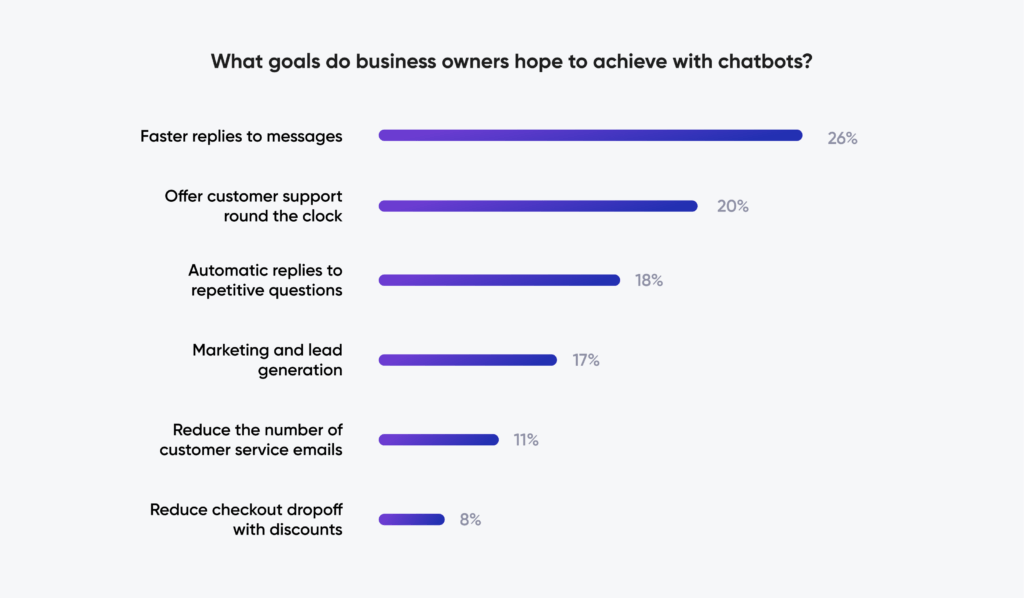
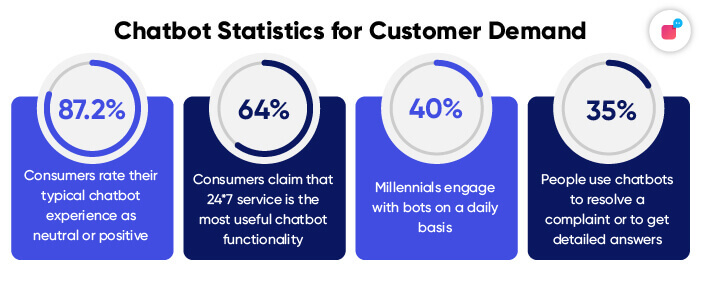
- 86% of customers believe there should be an escalate to agent option when talking to a chatbot – HubSpot
- 87.2% of consumers rate their typical chatbot experience as neutral or positive. (Master of Code Global)
- 80% of customers who have interacted with chatbots report a positive experience. (Uberall)
- 58% of websites employing chatbot software belong to B2B companies. (Boomtown)
- 90% of businesses report substantial enhancements at complaint resolution speed. (MIT Technology Review)
- Over 51% of customers expect a business to be available 24/7. (Ventura Beat)
- 87.2% of consumers rate their interactions with bots as neutral or positive. (Master of Code)
- Additionally, 62% of respondents prefer interacting with customer service digital assistants over waiting for human agents. (Master of Code)
- 43% of digital banking users in the US prefer to use a live chat or chatbot to address issues. (Finances Online)
- 60% of millennials have reported using chatbots, out of which 70% have had positive experiences. (Forbes)
- 35% of consumers want to see more businesses incorporating chatbots (ubisend)
Chatbot Statistics on Company Supply

- 88% of CX professionals believe AI will enhance, not replace, agents – (CCW Digital)
- 90% of businesses report that chatbots greatly improve the time taken to resolve queries. (MIT Technology Review)
- 65.1% of businesses who have implemented chatbots are involved in software (Relay)
- 58% of B2B companies use a chatbot on their website, as compared to 42% on B2C websites (AI Journal)
- 53% of companies identify AI as a tool for creating a ‘customer-first culture’ (Accenture)
- 47% of organisations are expected to implement chatbots for customer support services, and 40% are expected to adopt virtual assistants (Gartner)
- By 2023 chatbots have saved healthcare, retail and banking up to $1.42 billion globally. (Juniper Research)
-
A third of AI startup founders said chatbots would be the top AI consumer application by 2024-2025. (Emerj)
Chatbot Statistics on Challenges

- 64% of executives say that user adoption hesitancy is the main reason why they don’t intend to implement chatbots. (Accenture)
- 51% of companies don’t use chatbots. The technology can’t yet include client history for personalised experiences. (Accenture)
- 46% of people think that chatbots are used deliberately to keep them away from human agents. (GetVoip)
- For complex issues, 23% of consumers still prefer to have a face-to-face interaction. (American Express)
- Bots are capable of handling 30% of live chat communications and 80% of routine tasks. Master of Code
45-46% of surveyed people said they don’t trust voice assistants to correctly process the order or make payments (PwC)
Chatbot Numbers for Customer Acquisition
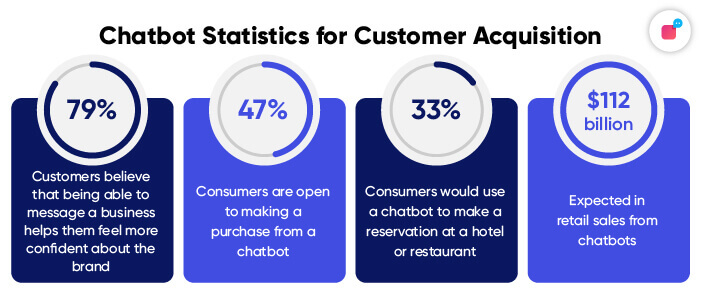
- 82% of Indian customers have messaged a business to make a purchase or reservation. (Facebook)
- 79% of customers believe that being able to message a business helps them feel more confident about the brand (Facebook)
- 67% of US millennial internet users would purchase a product/service from brands using a chatbot. (eMarketer)
- 57% of companies agree that conversational bots can deliver large returns on investment for minimal effort. (Accenture)
- Conversations between brands and customers via Facebook Messenger have a 30% better ROI than retargeting ads. (Business Insider)
- 47% of consumers are open to purchasing a chatbot. (HubSpot)
- 33% of consumers would use a chatbot to make a reservation at a hotel or restaurant. (Drift)
- The top 5 industries that profit from chatbots are real estate (28%), travel (16%), education (14%), healthcare (10%), and finance (5%). (Chatbots Life)
- eCommerce stores that adopted a Facebook Messenger bot + an Abandoned Cart flow boosted revenue by 7-25%. (Chatbots Magazine)
- Millennials are about twice as likely to use a personal shopper chatbot compared to age groups older than them. (Facebook)
- Only 14% of customers would choose the website form over getting answers from a chatbot. (Salesforce)
Suggested Reading: How to Calculate Customer Acquisition Cost (CAC) and Improve It?
Chatbot Statistics for Customer Support
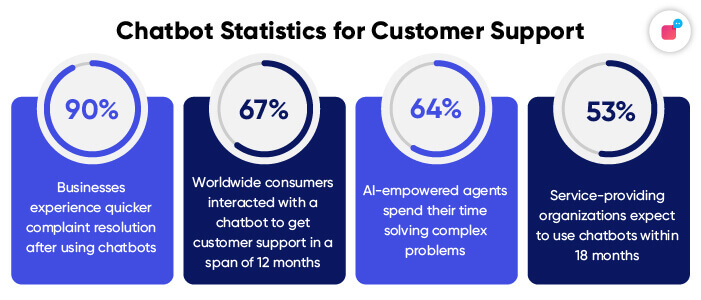
- 90% of businesses experience quicker complaint resolution after using chatbots. (MIT Technology Review)
- Chatbots are predominantly used to assist after-sales and customer service operations – at over 77%. (Accenture)
- In a 12-month span, 67% of worldwide consumers interacted with a chatbot to get customer support. (Facebook)
- 64% of businesses believe that chatbots will allow them to provide a more customised support experience for their customers. (Statista)
- 64% of AI-empowered agents spend their time solving complex problems versus 50% without AI chatbots. (Salesforce)
- 53% of service-providing organisations expect to use chatbots within 18 months — a 136% growth rate from the previous 18 months. (Salesforce)
- 90% of customers want an immediate response on their support query, where 60% of them defined “immediate” as less than 10 mins. (HubSpot Research)
- 34% of retail customers would be comfortable speaking with customer service through an AI chatbot instead of live chat. (Statista)
- 34% of online buyers said they would prefer to answer questions from AI via chatbots or virtual assistants. (Chatbots Magazine)
- Virtual customer assistants help organisations reduce call, chat and email inquiries by 70%. (Gartner)
- Chatbots can help brands save up to 30% on their customer support costs (IBM)
- 27% of consumers were unsure if the last customer support interaction they had was with a natural person or a chatbot (PwC)
- The #1 use case for chatbots is to get quick answers in an emergency, and the #2 use case is to resolve a complaint or question. (Drift)
- 48% of users prefer to interact with a chatbot that solves issues over a chatbot that has a personality. (Business Insider)
- 71% of consumers are satisfied with the voice assistants on their mobile devices. (Forbes)
- 43% of users between the ages of 16 and 64 use voice search and voice commands on various devices. (We Are Social)
- 70% of consumers will replace their visits to brick-and-mortar shops or banks with voice assistants over the next three years. (Capgemini) Related: Customer Support Automation and its Importance
- When it comes to shops and call centres, 49% of consumers prefer voice assistants over human interactions because they are faster [Voicify]
74% of the survey participants said they prefer to use voice technology when performing search queries. [Campaign Monitor]
Chatbot Statistics by Revenue

- The market for voice and speech recognition is expected to grow at a 17.2% CAGR to reach $26.8 billion by 2025. [Entrepreneur]
- Chatbot automation translates to $23 billion in savings from annual salaries. (BusinessInsider)
- Retail, banking, and healthcare have realised cost savings of $11 billion annually in 2023. (Juniper Research)
- Chatbots are projected to save 2.5 billion hours for businesses and consumers from chatbots by 2024 (Juniper Research)
- Chatbots are projected to save $0.70 per customer interaction (CNBC)
- 58% of customers say emerging technologies such as chatbots and voice assistants have changed their expectations of companies. (Salesforce)
- 54% of customers say companies need to transform how they engage with them. (Salesforce)
- By 2023, Juniper forecasts that over $142 billion of retail spend with chatbots. Juniper Research
- The insurance sector has saved $1.3 billion globally in 2023 from using chatbots. (Juniper Research)
- Seventy-nine percent of employees see AI technology as having a positive impact on business performance. Capterra
With customers expecting seamless, quick, and integrated support across multiple channels, it’s increasingly important for businesses to adapt. The trends highlighted in this blog show that a well-planned and executed customer support strategy not only improves efficiency but also delivers tangible financial benefits.
By investing in modern support tools—whether that means enhancing your help centre, integrating CRM data, or adopting automation where it matters—you position your business to earn higher revenues and foster stronger customer loyalty. Understanding and applying these customer service trends will help ensure that your support system meets the evolving needs of your customers in 2025 and beyond.
Taking action now means you can build a support system that isn’t just reactive, but one that actively contributes to your business growth and customer satisfaction over the long term.
FAQs
1. Which AI is considered superior to ChatGPT?
There isn’t a definitive “better” AI than ChatGPT, as performance depends on your specific needs. Some competitors—such as Google’s Bard or other emerging LLMs—offer differing capabilities, and the choice often boils down to factors like use-case focus, customisation options, and integration requirements.
2. What are the future trends for chatbots in 2025 and beyond?
Future chatbots are set to become more interconnected and emotionally aware. Expect to see greater integration with IoT devices, allowing seamless interaction across gadgets, and advancements in emotional AI, which will help chatbots recognise user sentiments and respond more naturally. Additionally, improved personalisation and deeper integration with business systems are likely trends.
3. What is the current growth rate of the chatbot market?
Market reports indicate that the global chatbot sector was valued at around USD 7.76 billion in 2024, and it is projected to grow at a compound annual growth rate (CAGR) of approximately 23.3% from 2025 to 2030, reflecting strong demand driven by AI and machine learning progress.
4. How fast is the chatbot sector expanding?
Chatbot adoption, particularly in sectors such as EdTech, is accelerating rapidly. For example, in 2021, AI-enabled solutions in education reached a valuation of $1.82 billion, with projections suggesting an annual growth of around 36% by 2030. This indicates a robust rate of expansion across industries.
5. What does the future hold for ChatGPT and AI technologies?
The future of ChatGPT and similar AI models appears promising, with ongoing improvements in language understanding and response quality. Researchers continue to refine these systems, addressing challenges like true semantic understanding and context retention. As these models evolve, they are expected to offer even more accurate, nuanced, and useful interactions, changing how we work with AI.
6. How should we approach understanding large language models (LLMs)?
Grasping LLMs involves recognising that while they generate responses that seem natural, their “understanding” is based on data patterns rather than true comprehension. It’s important to view them as powerful tools that simulate human-like conversation, and ongoing research, like that discussed by Terrence Sejnowski, is shedding light on their capabilities and limitations.






